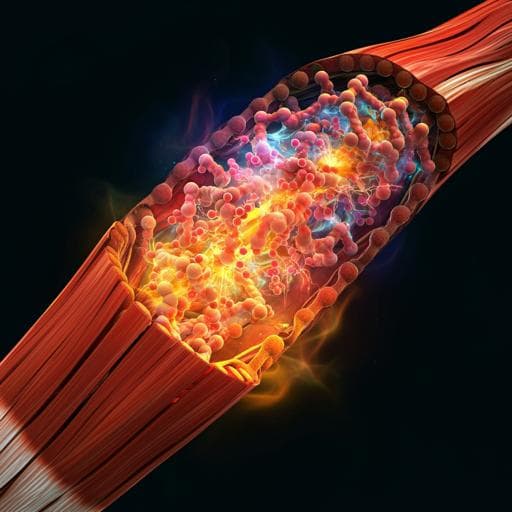
Biology
Disuse-associated loss of the protease LONP1 in muscle impairs mitochondrial function and causes reduced skeletal muscle mass and strength
Z. Xu, T. Fu, et al.
This research reveals the crucial role of LONP1, a key mitochondrial protease, in maintaining mitochondrial function and preserving skeletal muscle mass and strength during muscle disuse. Conducted by Zhisheng Xu and colleagues, the study highlights how reduced levels of LONP1 are linked to muscle atrophy and strength loss, a finding that could pave the way for new therapies in muscle degeneration.
~3 min • Beginner • English
Introduction
The study investigates how mitochondrial protein quality control, specifically via the matrix AAA+ protease LONP1, contributes to skeletal muscle mass and function during disuse. Mitochondria require continuous quality control; stress-induced disturbances in mitochondrial proteostasis are linked to aging and diseases, but their physiological relevance in vivo is not fully defined. Skeletal muscle adapts to activity level; disuse (e.g., denervation, immobilization, aging) causes atrophy and weakness. While muscle mass reflects a balance between synthesis and degradation, intrinsic signaling driving early disuse atrophy is unclear. Given LONP1’s conserved role in degrading misfolded/excess mitochondrial proteins and its reported regulation under stress and involvement in human disease, the authors hypothesize that LONP1-mediated mitochondrial proteostasis senses muscle disuse and regulates mitochondrial function and muscle mass/strength.
Literature Review
Prior work established mitochondrial proteases (ATP-dependent LONP1 and CLPP in the matrix; others in IMM/IMS) as first-line quality control, selectively removing damaged or unassembled proteins. LONP1 substrates include aconitase, COX4i1, STAR, and TFAM; Lonp1 deletion is embryonically lethal and LONP1 mutations cause CODAS syndrome. Altered LONP1 expression under stress is reported. Mitochondrial quality control (fusion/fission, mitophagy) is essential for muscle homeostasis; dysregulation of MFN1/2 or OPA1 impairs muscle mass/function. Disuse atrophy involves ubiquitin-proteasome E3 ligases (MAFbx/atrogin-1, MuRF1), and autophagy contributes to muscle mass regulation. However, whether matrix proteases like LONP1 act as disuse sensors and their in vivo impact on muscle had not been explored.
Methodology
- Human study: Supraspinatus muscle biopsies from 9 rotator cuff tear patients undergoing repair. MRI-based occupation ratio (muscle belly cross-section/supraspinatus fossa) quantified atrophy (non-atrophy mean 0.76; atrophy mean 0.50). Western blots for LONP1, CLPP, OPA1; correlations with occupation ratio. Ethical approval and informed consent obtained.
- Mouse disuse models: Sciatic nerve denervation or hindlimb immobilization in male WT mice; muscles harvested at 5, 10, 15 days. Western blots for mitochondrial proteases/dynamics proteins. MitoTimer reporter mice used to assess mitochondrial protein turnover (red:green ratio) in TA/EDL.
- Muscle-specific Lonp1 knockout (LONP1 mKO): Lonp1fl/fl crossed with HSA-Cre for postnatal skeletal muscle deletion (efficient by postnatal day 7). Confirmation across muscles; heart spared. Phenotyping: muscle weights (GC, TA), fiber CSA (WGA staining), grip strength, ex vivo EDL tetanic force, treadmill endurance and high-intensity RER/VO2, blood lactate after exercise; fiber type immunostaining and qPCR. RNA-seq (GC, 6 weeks). X-ray for kyphosis.
- Mitochondrial structure/function: TEM of soleus (SS/IMF) at 2 and 6 weeks; mtDNA content (Nd1/Lpl), Tim23, PGC-1α. Oroboros O2k respiration on isolated muscle mitochondria with pyruvate/malate or succinate/rotenone; ADP-stimulated and oligomycin conditions. BN-PAGE for OXPHOS complex assembly and in-gel activity (I, IV). Muscle ATP assay; AMPK activation by immunoblot.
- Protein turnover pathways: qPCR of atrophy-related genes (MAFbx, MuRF1, Fbxo31, Itch, SMART, MUSA1) at 2 and 6 weeks; FOXO3 phosphorylation; total ubiquitinated proteins; in vivo protein synthesis by SUnSET (puromycin incorporation); AKT/mTOR/S6K/4EBP1 phosphorylation.
- Autophagy/mitophagy: mt-Keima reporter crossed to LONP1 mKO to quantify mitophagy (red puncta) at 2 and 6 weeks in TA/EDL; autophagic flux in vivo using colchicine (0.4 mg/kg, twice within 24 h) and chloroquine (50 mg/kg every other day for 20 days) with LC3-II, p62 in mitochondrial fraction and whole muscle; TFEB nuclear localization and LAMP1 protein; rapamycin treatment (8 mg/kg/day, 4 weeks) in AAV-Cre model to probe mTOR dependence.
- Acute LONP1 deletion: AAV-Cre injected into TA/EDL of Lonp1fl/fl (control AAV-GFP) in 4-week-old mice; assessed 8 weeks later for LONP1 levels, muscle weight, EDL contractile force, mt-Keima mitophagy, LC3-II.
- In vitro primary myocytes: Lonp1fl/fl myoblasts infected with Ad-Cre or control then differentiated. Assessed myotube diameter, total protein/genomic DNA ratio, mitochondrial respiration (Seahorse/Oroboros-style protocol), GFP-LC3 puncta, autophagy flux with chloroquine; ubiquitination, protein synthesis, AKT/mTOR signaling; BN-PAGE for complex IV.
- Proteomics: iTRAQ mass spectrometry on isolated crude mitochondrial proteomes from WT and LONP1 mKO (n=2 per group), compared with MitoCarta 2.0; identified altered proteins (≥1.2-fold up or ≤0.83-fold down), including protein quality control, translation, respiration; heatmap clustering.
- PARK7 mechanistic studies: Western blot for PARK7 and PINK1 in Ad-Cre myotubes; Park7 mRNA by RT-qPCR; cycloheximide chase for PARK7 stability; co-immunoprecipitation of LONP1-GFP with PARK7-Flag in HEK293T; Park7 siRNA knockdown in LONP1-deficient myotubes with LC3-II/I ratios ± chloroquine to assess autophagy flux.
- Mitochondrial proteostasis overload model: MCK-ΔOTC transgenic mice (muscle-specific expression of mitochondrial-retained OTC deletion mutant). Validated ΔOTC expression (FLAG) in mitochondrial fraction; measured mitochondrial respiration (pyruvate/succinate), muscle size/weights (GC, TA), WGA CSA, EDL force, atrophy gene expression and AKT/mTOR signaling, LC3-II/I ratios, mt-Keima mitophagy in MCK-ΔOTC/mt-Keima mice.
- Rescue by LONP1 overexpression: AAV-LONP1 administered at P3 and P5 to MCK-ΔOTC; assessed ΔOTC protein, LC3-II, mitochondrial respiration, fiber size distribution.
- Statistics: Two-tailed unpaired t-tests or one-way ANOVA with Fisher’s LSD; Pearson correlation for human data; significance P<0.05.
Key Findings
- Disuse decreases LONP1 and slows mitochondrial protein turnover:
- In mice, denervation caused significant LONP1 protein reduction starting at day 5, concurrent with GC and TA muscle weight loss; CLPP and OPA1 decreased only at later stages, while MFN1/2 and DRP1 were unchanged. Immobilization also reduced LONP1 without altering CLPP/OPA1/MFN1/2/DRP1.
- MitoTimer red:green ratio increased after denervation (5 d) and immobilization (10 d), indicating slowed mitochondrial protein turnover.
- Human supraspinatus atrophy associates with reduced mitochondrial proteases:
- In 9 rotator cuff tear patients, atrophy group (mean occupation ratio 0.50) had significantly lower LONP1 and CLPP proteins than non-atrophy group (mean ratio 0.76); both LONP1 and CLPP positively correlated with occupation ratio. OPA1 showed no difference or correlation.
- Muscle-specific LONP1 deletion impairs growth and function:
- LONP1 mKO mice (postnatal skeletal muscle) developed reduced GC and TA muscle weights and fiber CSA by 6 weeks; denervation-induced atrophy was exacerbated.
- Grip strength reduced; ex vivo EDL tetanic force decreased to less than 50% of WT.
- Endurance markedly impaired: shorter running time and ~75% shorter distance; during high-intensity exercise, RER was higher, VO2 increase (ΔVO2) lower, and post-exercise blood lactate increased by ~56%.
- Fiber type shift toward type I (MHC1) with increased slow fiber gene expression and reduced fast fiber genes.
- RNA-seq: 982 genes upregulated and 940 downregulated; GSEA showed enrichment of aging-associated genes; kyphosis observed by 6–8 months.
- Mitochondrial structural and functional defects without reduced biogenesis:
- TEM revealed abnormal cristae (dilated/lost/vesiculated) and electron-dense aggregates in SS and IMF mitochondria at 2 and 6 weeks.
- mtDNA content, Tim23, and PGC-1α transcripts were unchanged; mitochondrial area and size similar to WT.
- Mitochondrial respiration (pyruvate or succinate substrates, ADP-stimulated) markedly reduced; BN-PAGE showed mild-to-moderate decreases in assembled complexes I, III, IV and reduced in-gel activity of I and IV; muscle ATP levels significantly lower; AMPK activated.
- Protein synthesis and ubiquitin-proteasome pathways largely unaffected:
- At 2 weeks, atrophy gene mRNAs not increased; ubiquitin system gene expression reduced at 6 and 16 weeks; FOXO3 phosphorylation unchanged; ubiquitinated protein content similar at 2 and 16 weeks.
- SUnSET protein synthesis rates and AKT/mTOR/S6K/4EBP1 signaling unchanged.
- Autophagy/mitophagy activation drives muscle loss:
- mt-Keima signals increased at 2 and 6 weeks in LONP1 mKO; colchicine increased mitochondrial-associated LC3-II more in LONP1 mKO, and whole-muscle LC3-II and p62 accumulated more vs WT, indicating enhanced autophagic flux; chloroquine treatment shifted fiber size distribution toward larger fibers in LONP1 mKO.
- TFEB nuclear localization and LAMP1 levels not increased, suggesting no lysosomal biogenesis activation.
- Acute AAV-Cre deletion in mature muscle recapitulated muscle weight loss, weakness, increased mt-Keima puncta, and LC3-II.
- In vitro Ad-Cre deletion in primary myotubes reduced diameter (45% decrease in protein/genomic DNA ratio), decreased respiration, and increased GFP-LC3 puncta and autophagic flux; UPS and protein synthesis unchanged.
- Denervation increased mt-Keima signal, LC3-II conversion, and reduced respiration; atrophy genes upregulated early as expected.
- Rapamycin increased small fiber percentage in both genotypes, supporting mTORC1-independent regulation by LONP1.
- LONP1-mediated proteostasis links to PARK7 and autophagy:
- Mitochondrial proteomics (iTRAQ) identified 618 mitochondrial proteins; 81 (13%) altered (55 up, 26 down) in LONP1 mKO, including proteins in matrix/IMM related to respiration, translation, QC.
- PARK7 protein increased ~5-fold in LONP1-deficient myotubes without mRNA change; PINK1 unchanged. PARK7 stability increased in CHX chase; co-IP showed LONP1-PARK7 interaction; Park7 siRNA reduced autophagy flux in LONP1-deficient myotubes, implicating PARK7 as a LONP1 substrate mediating autophagy activation.
- Mitochondrial misfolded protein burden is sufficient to induce pathology:
- Muscle-specific ΔOTC overexpression (MCK-ΔOTC) increased mitochondrial ΔOTC and LONP1, reduced mitochondrial respiration (pyruvate/succinate), decreased GC/TA weights and fiber CSA, and reduced EDL force.
- Atrophy gene expression, FOXO3, ubiquitinated proteins, and AKT/mTOR signaling unchanged; LC3-II/I increased and mt-Keima puncta elevated, indicating autophagy activation.
- AAV-LONP1 overexpression in MCK-ΔOTC reduced ΔOTC protein to undetectable/low, decreased LC3-II, improved mitochondrial respiration, and shifted fiber size distribution toward larger fibers.
Discussion
The findings demonstrate that LONP1 acts as an early and sensitive mitochondrial sensor to muscle disuse, linking mitochondrial protein quality control to maintenance of muscle mass and strength. Disuse reduces LONP1 before changes in other mitochondrial dynamics proteins, coinciding with slowed mitochondrial protein turnover and mitophagy activation. Genetic loss of LONP1 impairs mitochondrial structure and respiration, lowers ATP, and activates autophagy without affecting protein synthesis or the ubiquitin-proteasome system, leading to muscle atrophy and weakness. Mechanistically, accumulation of mitochondrial-retained proteins upon LONP1 loss (including PARK7) triggers autophagy-lysosome degradation; PARK7 mediates, at least in part, the autophagic response in LONP1-deficient muscle cells. Overloading mitochondrial proteostasis with ΔOTC is sufficient to recapitulate mitochondrial dysfunction, autophagy activation, and muscle atrophy, and is ameliorated by LONP1 overexpression, underscoring a causal role for LONP1-dependent proteostasis. The dissociation between increased type I fiber program and impaired mitochondrial energetics suggests compensatory fiber-type switching in response to energetic deficiency. Overall, the study positions LONP1-dependent mitochondrial proteolysis as a crucial regulator of muscle health during inactivity, potentially targetable to prevent or mitigate disuse atrophy.
Conclusion
This work identifies LONP1-dependent mitochondrial protein quality control as essential for preserving mitochondrial function and skeletal muscle mass and strength, particularly during disuse. Disuse lowers muscle LONP1 in mice and humans; muscle-specific LONP1 ablation impairs mitochondrial turnover and respiration, activates autophagy, and causes muscle atrophy and weakness. Proteostasis overload via mitochondrial-retained ΔOTC is sufficient to induce similar pathology and is rescued by LONP1 overexpression. PARK7 accumulation links LONP1 loss to autophagy activation. These findings establish a mechanistic link between mitochondrial proteostasis and muscle mass maintenance and suggest LONP1 as a potential therapeutic target for disuse-induced muscle loss and possibly age-related sarcopenia. Future studies should define how LONP1 is downregulated during disuse, identify broader LONP1 substrate networks in muscle, clarify interactions with other mitophagy pathways, and assess translational strategies to modulate LONP1 activity in humans.
Limitations
- The mechanism underlying LONP1 protein repression in disused muscle was not elucidated; possibilities include stress-induced damage and auto-degradation, requiring further study.
- Human data were limited to 9 rotator cuff patients and focused on the supraspinatus, potentially limiting generalizability.
- Proteomics used two biological replicates per group; validation of additional candidate substrates beyond PARK7 remains to be expanded.
- Overexpression and knockout models may not fully recapitulate physiological ranges; ΔOTC is an artificial proteostasis stress model.
- While autophagy activation is implicated, other pathways could contribute; mTORC1-independence inferred from rapamycin effects but not exhaustively mapped.
- Some measurements (e.g., BN-PAGE complex assembly) showed mild changes; causality between specific respiratory defects and atrophy is inferred.
- In vitro primary myotube findings may not capture in vivo complexity.
Related Publications
Explore these studies to deepen your understanding of the subject.







